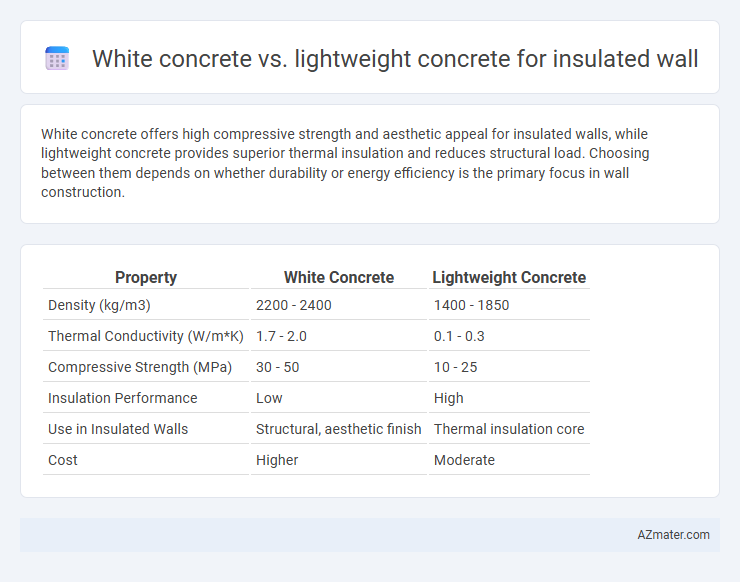White concrete offers high compressive strength and aesthetic appeal for insulated walls, while lightweight concrete provides superior thermal insulation and reduces structural load. Choosing between them depends on whether durability or energy efficiency is the primary focus in wall construction.
Table of Comparison
| Property | White Concrete | Lightweight Concrete |
|---|---|---|
| Density (kg/m3) | 2200 - 2400 | 1400 - 1850 |
| Thermal Conductivity (W/m*K) | 1.7 - 2.0 | 0.1 - 0.3 |
| Compressive Strength (MPa) | 30 - 50 | 10 - 25 |
| Insulation Performance | Low | High |
| Use in Insulated Walls | Structural, aesthetic finish | Thermal insulation core |
| Cost | Higher | Moderate |
Introduction: White Concrete vs Lightweight Concrete
White concrete provides excellent reflectivity and durability, making it ideal for insulated walls requiring thermal efficiency and aesthetic appeal. Lightweight concrete offers superior insulation properties due to its lower density, enhancing energy conservation and reducing structural load. Choosing between white and lightweight concrete depends on balancing thermal insulation needs with structural performance and design requirements.
Key Properties of White Concrete
White concrete exhibits superior thermal reflectivity and high compressive strength, making it an excellent choice for insulated walls that require both durability and energy efficiency. Its low thermal conductivity enhances insulation performance by reducing heat transfer, contributing to better indoor temperature regulation. The material also offers excellent aesthetic versatility due to its bright, uniform color, which can reduce cooling costs in hot climates when used on exterior surfaces.
Key Properties of Lightweight Concrete
Lightweight concrete offers superior thermal insulation due to its lower density, typically ranging from 1,200 to 1,800 kg/m3, compared to white concrete's density of about 2,400 kg/m3, making it ideal for insulated walls. Its enhanced fire resistance, improved sound absorption, and reduced dead load contribute to energy-efficient and structurally optimized construction. Furthermore, lightweight concrete's high porosity and excellent freeze-thaw durability improve building performance in varied climatic conditions.
Thermal Insulation Performance Comparison
White concrete typically exhibits higher thermal mass due to its dense composition, which can result in slower heat transfer but less effective insulation compared to lightweight concrete. Lightweight concrete, often containing air-entraining agents or lightweight aggregates such as expanded clay or perlite, provides superior thermal insulation performance by reducing thermal conductivity and enhancing energy efficiency in insulated walls. Studies show lightweight concrete can lower heat transfer rates by up to 30% compared to standard white concrete, making it a preferred choice for thermal insulation in building envelopes.
Structural Strength and Durability
White concrete offers superior structural strength and durability due to its dense composition and higher compressive strength, making it ideal for load-bearing insulated walls. Lightweight concrete provides enhanced thermal insulation with reduced weight but has lower compressive strength and may require additional reinforcement for structural applications. For insulated walls demanding both strength and longevity, white concrete ensures better resistance to environmental wear and load stress compared to lightweight alternatives.
Energy Efficiency and Sustainability
White concrete offers high thermal mass, improving energy efficiency by stabilizing indoor temperatures and reducing heating and cooling demands. Lightweight concrete provides superior insulation due to its lower density and porous structure, leading to enhanced thermal resistance and energy savings in insulated walls. From a sustainability perspective, lightweight concrete often incorporates recycled materials and reduces structural load, lowering the environmental impact of construction compared to traditional white concrete.
Aesthetic and Design Flexibility
White concrete offers superior aesthetic appeal with its bright, clean finish that enhances natural light reflection and provides a versatile canvas for architectural designs. Lightweight concrete delivers greater design flexibility due to its reduced density, allowing for varied shapes and complex forms without compromising thermal insulation in insulated wall applications. Both materials support innovative construction, but white concrete excels in visual impact while lightweight concrete prioritizes adaptability and insulation efficiency.
Cost Analysis and Budget Considerations
White concrete typically costs more due to the use of white cement and color additives, increasing initial material expenses compared to lightweight concrete, which incorporates aggregates like expanded clay or shale that reduce material costs and improve thermal insulation. Lightweight concrete offers budget advantages by lowering structural load, potentially reducing foundation and support costs, while white concrete may require additional insulation to meet thermal performance standards, adding to overall expenditure. For insulated wall projects, evaluating the balance between upfront material costs and long-term energy savings is crucial, with lightweight concrete providing a cost-effective solution for both insulation and structural efficiency.
Installation Methods and Construction Efficiency
White concrete offers straightforward installation with conventional formwork and curing practices, leading to reliable construction efficiency in insulated wall systems. Lightweight concrete requires specialized handling techniques such as controlled mixing and gentle compaction to maintain its thermal properties, potentially increasing installation time. Selection depends on balancing installation ease of white concrete against the superior insulation benefits and corresponding construction adjustments of lightweight concrete.
Best Applications for Insulated Wall Systems
White concrete offers high thermal mass and superior durability, making it ideal for insulated wall systems in commercial and high-traffic buildings that require energy efficiency and long-term performance. Lightweight concrete provides excellent insulation properties due to its low density and air content, making it the best choice for residential insulated wall systems where thermal resistance and ease of installation are priorities. Selecting between white and lightweight concrete depends on balancing the need for thermal mass, insulation value, structural strength, and specific climatic conditions.

Infographic: White concrete vs Lightweight concrete for Insulated wall
 azmater.com
azmater.com